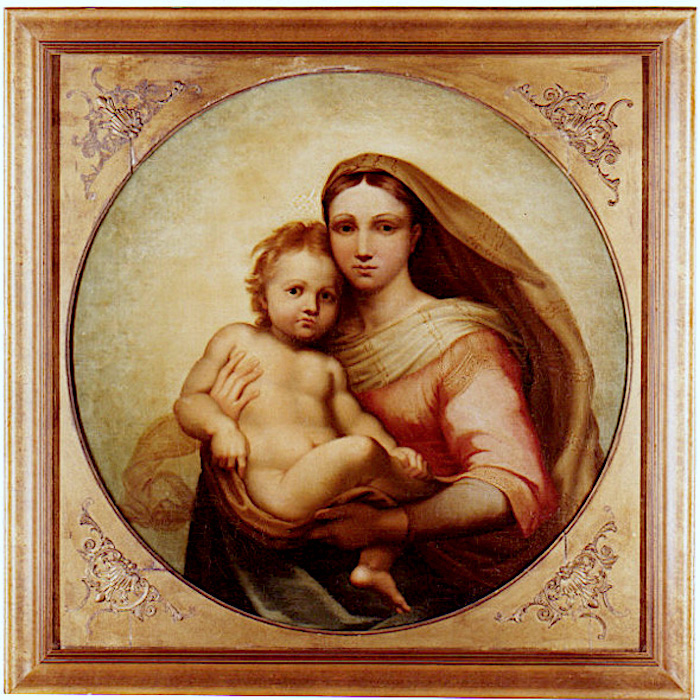The de Brécy Trust has used AI to authenticate a painting that has been in their collection for over 40 years. The artwork is hoped to be by the Renaissance master Raphael. The picture will now go on display in Bradford.
Thousands of images were compiled to create an algorithm that pointed directly to a sister painting in the Vatican Art Collection. 75% would have confirmed an exact match, however, the similarity between the Madonna was 97%, while approximating the child in both produced an 86% similarity. Only four undisputed works painted on canvas by Raphael exist. But is this accurate enough? Several Raphael scholars have denied the painting’s authenticity claiming it is a Victorian copy of a painting in the Vatican collection.
Eight independent Laboratories have examined the materials of the painting and their findings are summarised below. The Canvas Support: The support is made of flax with a faint red earth colouring and is a tight, plain, tabby weave of outstanding quality. Although thin and tightly woven, the threads are uneven, indicating that the flax has been hand-spun and hand-woven.
‘The Paint: Examination of paint samples by stereo microscope and comparison against reference slides identified the pigments red madder lake, yellow ochre, burnt sienna, lead white and Prussian Blue. All of these pigments (except Prussian Blue) have been used by artists from early times. Examination by scanning electron microscope revealed that the paint layer is fragile and in cross-section can be seen several distinct and discrete strata of paint, usually three, having the character of thin glazes. It also revealed no pigment particles in the blue paint layer’.

‘The blue colour from seven diverse areas was submitted to elemental analysis by energy dispersive x-ray, using an electron microprobe. This test established that it contained no iron or other metal elements, apart from a few inclusions of lead derived from the lead white ground, thus refuting the identification of Prussian Blue, of which iron is the main element.
“In September 2004, I undertook Raman spectroscopic analysis of paint samples from the de Brécy Trust’s tondo painting of the Madonna and Child. The analysis found clear evidence of using the yellow (lead monoxide, PbO ) pigment massicot. This pigment is considered to be in pre-17th century usage by artists. The presence of lead white was also registered in the analysis. The analysis also indicated that the medium was not an oil or resin nor made from gum, animal glue or egg white. It is, therefore, most likely to be of a vegetable-derived, starch-based glue (considered typical of Renaissance practice). From these analytical findings, I am confident that the tondo painting is consistent with an early, pre-1700 Renaissance work.” – Statement of Professor Howell Edwards, M.A., D.Phil., B.Sc., C.Chem., FRSC, Professor of Molecular Spectroscopy, University of Bradford:
The canvas of the Tondo is a fine, plain, tabby weave similar to that produced in sixteenth-century Italy. Having examined (24 August 1989) the reverse of the Trinity Standard in Citta di Castello, it is possible to say that the fabric of the Trinity canvas seems to be almost identical to that of the Tondo: the fineness and the irregularity of the weave are comparable and the colour was the same earth red. The fabric of the standard, which is the original, appears to be in the same good condition as Tondo’s canvas. The standard is an exciting example that canvas from 1500 can survive without relining or strengthening.
The Tondo’s provenance includes Mrs Violet Hope Fairbairn Wynne-Eyton (1892-1981) of Leeswood Hall, Mold, North Wales, who hung the Tondo above the open fireplace in her bedroom. The painting was known to have existed in the Wynne-Eyton family art collection for generations [1]. The collector, the late George Lester Winward, acquired it from her Executors on 3 December 1981 at an auction sale conducted at Leeswood Hall by Henry Spencer & Sons of Retford, Nottingham – lot 249.
Historical research propounds that the picture belonged to Sir Richard Wynn (1588-1649), a member of the influential and aristocratic Welsh family the ‘Wynns of Gwydir’ and subsequently to the prestigious art collection of his descendant Sir Watkin Williams-Wynn, Fourth Baronet (1749-89). Mrs Wynne-Eyton was related to both, as the Wynne-Eytons are a cadet branch of the Williams-Wynn family.
An infra-red infrared examination of the painting’s reverse canvas flap revealed a monogram, which accords with the personal insignia of Queen Henrietta Maria. Sir Richard Wynn was Treasurer and Receiver General to Henrietta Maria from 1629 to 1649 and, as such, responsible (among other things) for settling accounts relating to her art collection, much of which came by gift from the Vatican to bolster her Catholic faith. Lothian recounts that Queen Henrietta Maria owed money to Sir Richard Wynn regarding a substantial loan. Thus the Tondo might have passed to Sir Richard on account of such debt or as a gift from the Vatican for services rendered.
The de Brécy Trust Collection comprises a variety of paintings, drawings, etchings and prints. Works range from the sixteenth-century Italian School, Dutch and Flemish pictures from the seventeenth century and work from the eighteenth and early nineteenth-century English School. They are mostly small in size and, in some cases, miniature.

